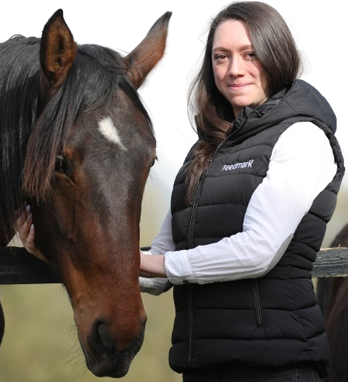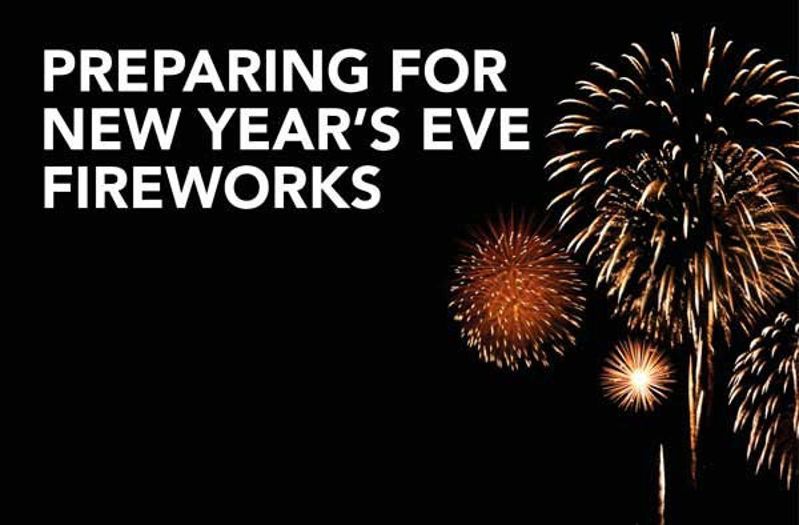New Year celebrations can be joyful and filled with hope for the year ahead but for horse and pet owners it can also mean additional stress from fireworks. The days during the festive period are a good time to prepare for New Year's Eve fireworks and to manage the stress for your horse.
Fireworks elicit fear reactions in many animals, including horses, due to the unpredictable, intermittent and high-intensity sounds (Cracknell and Mills, 2008) combined with light flashes, burning smells and changes in barometric pressure (Riva et al. 2022). Horses are both prey and flight animals (Goodnight, 2007), and as such can be highly unpredictable when scared (LeGuin et al. 2005; Saslow, 2002). Fear based behaviours in horses are numerous and include sweating, shaking, running and escape attempts (Lavoie, 2019). These behavioural responses can be particularly dangerous, with the potential to result in severe injury to the horse, as well as to the rider or handler (McGreevy et al. 2014).
The first study to investigate the horse’s response to fireworks was published in 2016 (Gronqvist et al. 2016). 1111 horse owners in New Zealand, responsible for 6431 horses, completed an online survey, with 1104 (99.4%) of the owners reporting that their horse(s) exhibited fear-based behaviours in response to fireworks. Running was the most common behaviour reported (82%), followed by trembling, sweating and fence walking. 35% of owners reported that their horse(s) had previously broken through fences in response to fireworks, with 26% of owners reporting that their horse(s) had received injuries due to fireworks.
Cracknell and Mills (2008) proposed that the noise from fireworks that causes anxiety in horses, more than the sight or smell. This is supported by a study in which the sound of fireworks played from a CD player resulted in higher cortisol levels in horses (a hormone that indicates anxiety), compared to the sound of clipper blades or social isolation (Young et al. 2012).
A recent study published in 2022 by Riva et al. investigated the effect that noisy events, such as fireworks, has on horse behaviour in the UK and USA. 1836 questionnaires were completed by horse owners in the UK and USA, with 409 owners reporting that their horses had shown unusual behaviours during noisy events. Fence/box walking and running were the most observed activities, immediately followed by sweating, however appetite loss, diarrhoea, breaking fences, weaving, bucking, fever, trembling and vocalization were also seen.
This is supported by an earlier study conducted (Lindstedt, 2020) that aimed to assess the anxiety of horses due to firework related noises. 774 horse owners in Finland and Sweden answered an online survey about the behaviour of their horses during the previous New Year’s Eve. The results from the Finnish questionnaire indicated that 30.2% of horses showed anxious behaviours in response to fireworks, whereas this increased to 54.7% in the Swedish questionnaire. In agreement with Riva et al. (2022) the anxious behaviours seen included decreased appetite, diarrhoea/increased defecation, running in the box, sweating, trying to escape and trembling. In addition, of the owners that completed the questionnaire 7.9% of horses in Finland and 8.9% in Sweden horses injured themselves due to panic related to the noise from fireworks. Interestingly horses that were observed during New Year's Eve were four times more likely to have anxious behaviours reported by their owners, compared to horses that were not observed. This indicates that even if horse appears to be acting normally the morning after fireworks displays there is a strong likelihood that they have been anxious during the night.
These studies highlight the importance of trying to reduce anxiety levels for horses during times of the year when fireworks displays are likely. We are often able to desensitise our horse to situations that worries them, but as fireworks are intermittent and high-intensity noisy events, and therefore totally unpredictable for horses, this makes the habituation process almost impossible (Riva et al. 2022). There are however some things owners can do to help support their horses during these times.
Preparing for New Year's Eve:
- Ask friends and neighbours to inform you of anything they have heard of or have planned themselves
- Monitor local papers, radio stations and shops to see what NYE events mention fireworks
- Check stables and fields to make sure they are secure and there is nothing the horse can injure themselves on should they get frightened
- Ensure you have adequate 3rd party liability insurance, in case your horse does escape and cause damage or an accident
- If your horse is particularly nervous consider feeding a daily calmer, such as Steady-Up®, prior to New Year's Eve.
- Have a ‘fire’ plan in place - make sure that if there is an emergency there are enough people to remove horses to a safe place
- To help drown out noise, get your horses used to a radio being on in the yard
On New Year's Eve
- It is normally advised to keep to your horse in their normal routine - if your horse is normally stabled at night it is probably best to leave them in, but if they are used to being out this may suit them better
- Give horses ad-lib hay or haylage to help to keep them occupied
- Leave on the radio to help drown out sounds (acclimatise your horses to this first, if not the radio itself may worry them!)
- Leaving lights on makes flashes less obvious
- Check on the horses after midnight to ensure they are not overly distressed
- If you horse is in, pop them in rug that will help them keep warm and will also wick sweat away. If they live out, it may be worth putting a wicking rug under their usual turnout, so they don’t get wet and cold if they do run around
- Shut exterior gates where possible - stressed horses may push through stable doors or jump out of fields
On New Year's Day
- Thoroughly check over your horses in daylight to make sure there were no injuries or problems missed
- Before you turn out, check your horse's field for any stray bits of firework or debris that could lead to accidents
References
- Cracknell, N. and Mills, D. (2008). ‘A double-blind placebo-controlled study into the efficacy of a homeopathic remedy for fear of firework noises in dog (Canis Familiaris)’, The Veterinary Journal, 177, pages 80 - 88
- Goodnight, J. (2007) Horse Psychology & the Language of Horses. Available at https://extadmin.ifas.ufl.edu/media/extadminifasufledu/cflag/image/docs/fl-equine-institute/2007/HorsePsychLanguage.pdf
- Gronqvist, G., Rogers, C. and Gee, E. (2016) The management of horses during fireworks in New Zealand’, Animals, 6(3), page.20
- Lavoie, J.P. (2019) ‘Blackwell's five-minute veterinary consult: equine’ John Wiley & Sons.
- LeGuin, E., Raber, K. and Tucker, T.J. (2005) ‘Man and Horse in Harmony’, In the Culture of the Horse: Status, Discipline, and Identity in the Early Modern World; Palgrave Macmillan US: New York, NY, USA
- Lindstedt, J.S.M. (2020) Fireworks related equine noise anxiety in Finland and Sweden (Master's thesis, Eesti Maaülikool). Available at https://dspace.emu.ee/xmlui/bitstream/handle/10492/5849/Lindstedt_final-thesis_2020.pdf?sequence=1&isAllowed=n
- McGreevy, P.D., Henshall, C., Starling, M.J., McLean, A.N. and Boakes, R.A (2014) ‘The importance of safety signals in animal handling and training’, Journal of Veterinary Behavior: Clinical Applications and Research, 9, pages 382–387.
- Riva, M.G., Dai, F., Huhtinen, M., Minero, M., Barbieri, S. and Dalla Costa, E. (2022) ‘The Impact of Noise Anxiety on Behavior and Welfare of Horses from UK and US Owner’s Perspective’, Animals, 12 (10), page 1319
- Saslow, C. (2002). ‘Understanding the perceptual world of horses’, Applied Animal Behaviour Science, 78, pages 209 – 224
- Young, T., Creighton, E., Smith, T. and Hosie, C. (2012) ‘A novel scale of behavioural indicators of stress for use with domestic horses’, Applied Animal Behaviour Science, 140 (1-2), pages 33 - 43.












